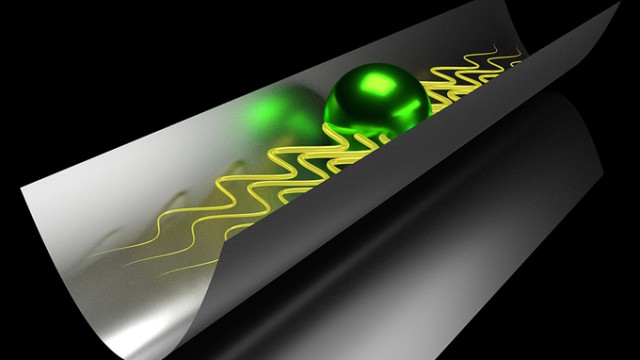6 June 2017

In the quantum world, our intuition for moving objects is strongly challenged and may sometimes even completely fail. An international team of physicists of the Universities of Innsbruck, Paris-Sud and Harvard as well as the Technical University of Munich (TUM) has found a quantum particle which shows an intriguing oscillatory back-and-forth motion in a one-dimensional atomic gas instead of moving uniformly.
A ripe apple falling from a tree has inspired Sir Isaac Newton to formulate a theory that describes the motion of objects subject to a force. Newton’s equations of motion tell us that a moving body keeps on moving on a straight line unless any disturbing force may change its path. The impact of Newton’s laws is ubiquitous in our everyday experience, ranging from a skydiver falling in the earth’s gravitational field, over the inertia one feels in an accelerating airplane, to the earth orbiting around the sun.
In the quantum world, however, our intuition for the motion of objects is strongly challenged and may sometimes even completely fail. In the current issue of “Science” an international team of physicists from Innsbruck, Munich, Paris and Cambridge (USA) describes a quantum particle that shows a completely unexpected behavior.
In a quantum gas the particle does not move like the famous falling apple, but it oscillates. At the heart of this surprising behavior is what physicists call ‘quantum interference’, the fact that quantum mechanics allows particles to behave like waves, which can add up or cancel each other.
Approaching absolute zero temperature
To observe the quantum particle oscillating back and forth the team had to cool a gas of Cesium atoms just above absolute zero temperature and to confine it to an arrangement of very thin “tubes” realized by high-power laser beams. With a special trick, the atoms were made to interact strongly with each other. At such extreme conditions the atoms form a quantum fluid whose motion is restricted to the direction of the tubes. The physicists then accelerated an impurity atom, which is an atom in a different spin state, through the gas. In our everyday world this corresponds to the apple falling from the tree. The scientists, however, observed that the quantum wave of the atom was scattered by the other atoms and reflected back again. The result is a striking oscillatory movement. The experiment demonstrates that Newton’s laws cannot be used in the quantum realm.
Quantum fluids sometimes act like crystals
The fact that a quantum-wave may get reflected into certain directions has been known since the early days of the development of the theory of quantum mechanics. For example, electrons reflect at the regular pattern of solid crystals, such as a piece of metal. This effect is termed “Bragg-scattering”. However, the surprise in the experiment performed in Innsbruck was that no such crystal was present for the impurity to reflect off. Instead, it was the gas of atoms itself that provided a type of hidden order in its arrangement, a property that physicist dub “correlations”. The publication has demonstrated how these correlations in combination with the wave-nature of matter determine the motion of particles in the quantum world and lead to novel and exciting phenomena that counteract the experiences from our daily life.
Understanding fundamental processes in electronics components
“Understanding the oddity of quantum mechanics is also relevant in a broader scope,” says Michael Knap, Professor for Collective Quantum Dynamics at the Technical University of Munich. “It might help to understand and optimize fundamental processes in electronics components, or even transport processes in complex biological systems.”
The research was funded by the European Science Council (ERC), the Austrian Science Fund (FWF), the National Science Foundation (NSF) and the US Air Force’s Office of Scientific Research (AFOSP), the Alexander von Humboldt Foundation, the Max Planck Institute for Quantum Optics and the TUM Institute for Advanced Study. In addition to the Walter Schottky Institute of the TU Munich, the Center for Quantum Physics of the University of Innsbruck, the Laboratoire de Physique Théorique et Modèles Statistiques of the University of Paris-Sud and the Physics Department of the Harvard University (Cambridge, Massachusetts, USA) were involved in the research work.
Publication Bloch oscillations in the absence of a lattice
Florian Meinert, Michael Knap, Emil Kirilov, Katharina Jag-Lauber, Mikhail B. Zvonarev, Eugene Demler, Hanns-Christoph Nägerl Science, June 2, 2017 DOI:
10.1126/science.aah6616
Contact
Prof. Dr. Michael Knap
For the original press release, please visit here